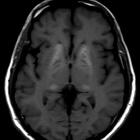acquired hepatocerebral degeneration










Acquired hepatocerebral degeneration is an uncommon irreversible extrapyramidal neurodegenerative condition encountered in patients with cirrhotic chronic liver disease, resulting in widespread cerebral, basal ganglia and cerebellar damage.
Terminology
Acquired hepatocerebral degeneration is a term that is restricted to patients which cirrhotic liver disease resulting from a variety of causes but specifically excluding Wilson disease; in fact this condition is often termed acquired non-Wilsonian hepatocerebral degeneration to ensure the distinction is made.
Acute neurological dysfunction from hyperammoniaema or other transient alterations in hepatic metabolism is termed hepatic encephalopathy and is discussed separately. Occasionally acquired hepatocerebral degeneration is referred to as chronic hepatic encephalopathy, although this is probably best avoided.
Clinical presentation
Patients with acquired hepatocerebral degeneration usually, but not always, have had multiple prior episodes of hepatic encephalopathy . They present with gradual neurological dysfunction including dementia, rigidity, dysarthria, gait ataxia, tremor and choreoathetosis .
Pathology
Although the pathophysiology of acquired hepatocerebral degeneration is uncertain, manganese overload is believed to be part of the disease and responsible for the T1 shortening observed in the globus pallidus .
Radiographic features
MRI
- T1
- intrinsic high signal intensity in the globus pallidus +/- subthalamic region, and midbrain (substantia nigra)
- thought to be a reflection of increased tissue concentrations of manganese
- may reverse following liver transplantation
- T2
- increased signal in the middle cerebellar peduncles (MCP sign)
Treatment and prognosis
Acquired hepatocerebral degeneration is generally thought to be irreversible, although recovery following liver transplantation has been reported .
Siehe auch:

 Assoziationen und Differentialdiagnosen zu acquired hepatocerebral degeneration:
Assoziationen und Differentialdiagnosen zu acquired hepatocerebral degeneration:
